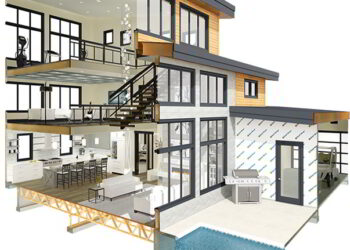Exploring the world of Eco-Friendly Materials for Exterior Contractor Projects uncovers a realm of possibilities where sustainability meets innovation. From durable options to energy-efficient designs, this topic delves into the key components that shape modern construction practices. Let's embark on a journey filled with insights and inspiration.
As we delve deeper, we will uncover the different types of eco-friendly materials, sustainable sourcing practices, energy-efficient building design, and recyclable options that contribute to a greener future in construction projects.
Types of Eco-Friendly Materials
Using eco-friendly materials in exterior contractor projects is not only beneficial for the environment but also for the longevity and sustainability of the structures. Let's explore some of the popular eco-friendly materials used in such projects:
Recycled Plastic Composite
Recycled plastic composite materials are made from recycled plastic and wood fibers, offering a durable and low-maintenance option for exterior projects. These materials are resistant to rot, decay, and insects, making them a sustainable choice for decking, fencing, and outdoor furniture.
An example of successful utilization of recycled plastic composite is in the construction of eco-friendly parks and playgrounds.
Bamboo
Bamboo is a rapidly renewable resource that is strong, lightweight, and versatile, making it an ideal material for exterior projects. It is commonly used for decking, flooring, and fencing due to its durability and natural aesthetics. Bamboo is known for its quick growth and minimal environmental impact, making it a sustainable choice for outdoor structures.
Successful projects incorporating bamboo include eco-friendly resorts and sustainable homes.
Reclaimed Wood
Reclaimed wood is salvaged from old structures like barns, factories, and warehouses, giving new life to the wood and reducing the demand for fresh timber. It adds a rustic and unique look to exterior projects like siding, decking, and pergolas.
Reclaimed wood is prized for its character and history, making it a popular choice for eco-conscious contractors. Successful examples of reclaimed wood projects can be seen in historic building renovations and eco-friendly cabins.
Recycled Glass
Recycled glass is a versatile material that can be used in exterior projects for countertops, tiles, and decorative elements. By using recycled glass, contractors can reduce waste in landfills and conserve natural resources. The vibrant colors and textures of recycled glass make it a visually appealing choice for sustainable design.
Successful projects incorporating recycled glass include eco-friendly public art installations and green buildings.
Sustainable Sourcing Practices

When it comes to exterior contractor projects, sourcing materials sustainably is crucial for the environment and local communities. By opting for sustainable sourcing practices, contractors can minimize the negative impact on ecosystems and support ethical business practices.
Criteria for Identifying Sustainably Sourced Materials
- Look for materials that come from renewable sources, such as certified wood from responsibly managed forests.
- Consider the energy and water usage during the production of the materials to ensure they are environmentally friendly.
- Check for certifications like FSC (Forest Stewardship Council) or LEED (Leadership in Energy and Environmental Design) to guarantee sustainable sourcing.
- Evaluate the transportation methods used to bring the materials to the project site to reduce carbon emissions.
Impact of Sustainable Sourcing
- Sustainable sourcing helps in conserving natural resources and reduces the carbon footprint of exterior projects.
- Local communities benefit from sustainable practices through job creation, fair wages, and the promotion of ethical business standards.
- By choosing sustainably sourced materials, contractors contribute to the preservation of biodiversity and ecosystems.
- Long-term sustainability is ensured when materials are sourced responsibly, leading to a positive impact on future generations.
Energy-Efficient Building Design
Eco-friendly materials play a crucial role in enhancing energy efficiency in exterior projects. By using sustainable materials like recycled metal, reclaimed wood, or energy-efficient glass, contractors can significantly reduce the energy consumption of buildings and minimize their environmental impact.
Optimizing Energy Consumption
When designing projects with eco-friendly materials, it is essential to focus on optimizing energy consumption
- Proper Insulation: High-quality insulation materials like cellulose or recycled denim can prevent heat loss in winter and keep buildings cool in summer, reducing the reliance on HVAC systems.
- Energy-Efficient Windows: Installing windows with low-emissivity coatings can minimize heat transfer and reduce the need for artificial lighting and heating during the day.
- Passive Solar Design: Orienting buildings to maximize natural light and heat gain can optimize energy consumption and create a more comfortable indoor environment.
By implementing these energy-efficient design strategies, buildings can reduce their energy consumption by up to 50% compared to those constructed with traditional materials.
Recyclable and Biodegradable Options
When it comes to eco-friendly exterior contractor projects, using recyclable and biodegradable materials is essential for reducing environmental impact. These materials not only help minimize waste but also promote sustainability in construction practices.
Recyclable Materials
- Recycled steel: Utilizing recycled steel in structures like beams and columns can significantly reduce the carbon footprint of a project. This material is durable and can be easily recycled at the end of its lifecycle.
- Recycled plastic: Incorporating recycled plastic lumber for decking and fencing is a great way to divert plastic waste from landfills. It is low-maintenance and long-lasting, making it a sustainable choice for outdoor applications.
- Recycled glass: Using recycled glass in landscaping features like mulch or decorative elements adds a unique touch to projects. Glass can be crushed and repurposed, reducing the need for virgin materials.
Biodegradable Materials
- Bamboo: Bamboo is a fast-growing and renewable material that can be used for decking, siding, and fencing. It is biodegradable, making it a sustainable alternative to traditional wood products.
- Cork: Cork is harvested from the bark of cork oak trees without causing harm to the tree itself. It is biodegradable, lightweight, and has natural insulating properties, making it ideal for exterior applications like roofing and cladding.
- Jute: Jute is a natural fiber that can be used for erosion control mats, landscaping fabrics, and even biodegradable packaging. It is compostable and helps reduce soil erosion, making it an eco-friendly choice for outdoor projects.
Concluding Remarks

In conclusion, Eco-Friendly Materials for Exterior Contractor Projects offer a promising path towards sustainable construction practices. By embracing these materials, we not only enhance the longevity of our projects but also minimize our impact on the environment. Let's continue to build a greener world, one project at a time.
FAQ Insights
What are some common eco-friendly materials used in exterior contractor projects?
Common eco-friendly materials include bamboo, reclaimed wood, recycled metal, and recycled glass.
How does sustainable sourcing benefit exterior projects?
Sustainable sourcing ensures that materials are responsibly harvested, reducing environmental impact and supporting local communities.
Can eco-friendly materials help in optimizing energy consumption in building design?
Yes, eco-friendly materials contribute to better insulation and energy efficiency, leading to reduced energy consumption in projects.
What are some examples of recyclable materials suitable for exterior projects?
Recyclable materials like steel, aluminum, and certain types of plastics can be incorporated into exterior contractor projects.












